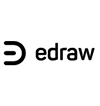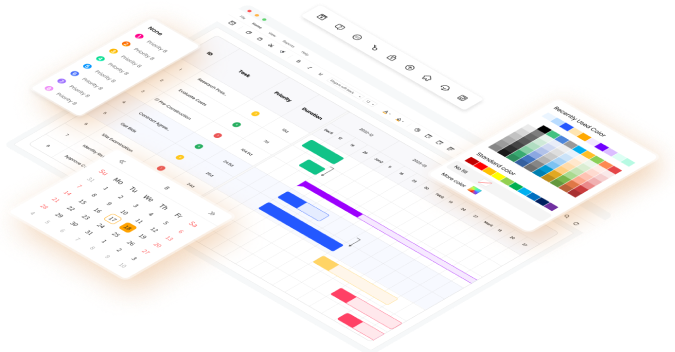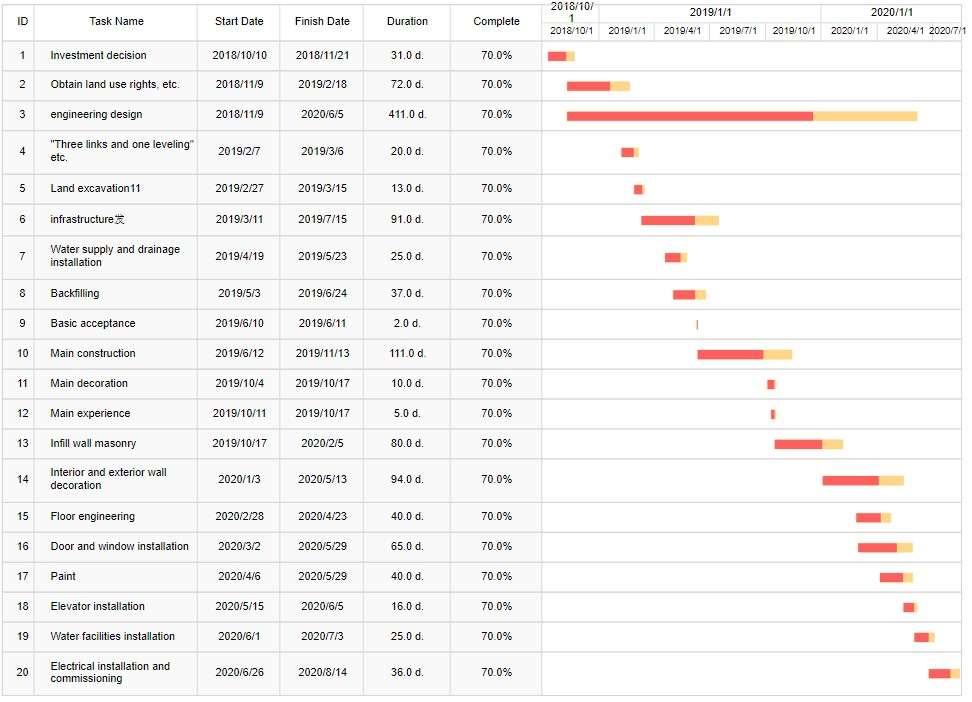
Picture this: You're launching a new construction project with blueprints, materials, and crew ready. But how do you ensure seamless execution from start to finish? A construction work programme provides the answer. It meticulously outlines all tasks, their sequence, and estimated durations, enabling you to maintain schedule adherence, prevent delays, and control budgets effectively.
Developing a successful programme requires deep understanding of project scope, resources, and potential challenges. To build a solid foundation before breaking ground, continue reading. This guide explores construction work programmes in depth, highlighting their practical applications and critical importance. By the end, you'll understand how to create your own using a professional construction work programme sample.
What Is a Construction Programme?
A construction work programme, also known as a programme of works (POW), provides a comprehensive outline of the entire construction process from initiation to completion. It details activity sequences, resource requirements, and timelines for each project phase. The primary objective is to ensure projects are delivered on time, within budget, and meeting quality standards.
Here are the essential components to include in a professional construction work programme:
Project Overview
- Project Name and Description
- Client and Contractor Information
- Project Location and Scope of Work
- Project Objectives and Success Criteria
Project Schedule
- Breakdown of Work Phases and Milestones
- Detailed Task Breakdown with Estimated Durations
- Task Interdependencies and Critical Path
- Visual Gantt Chart Schedule Representation
Resource Allocation
- Labor Requirements by Task and Phase
- Material and Equipment Specifications
- Subcontractor and Vendor Contracts
- Resource Availability and Scheduling
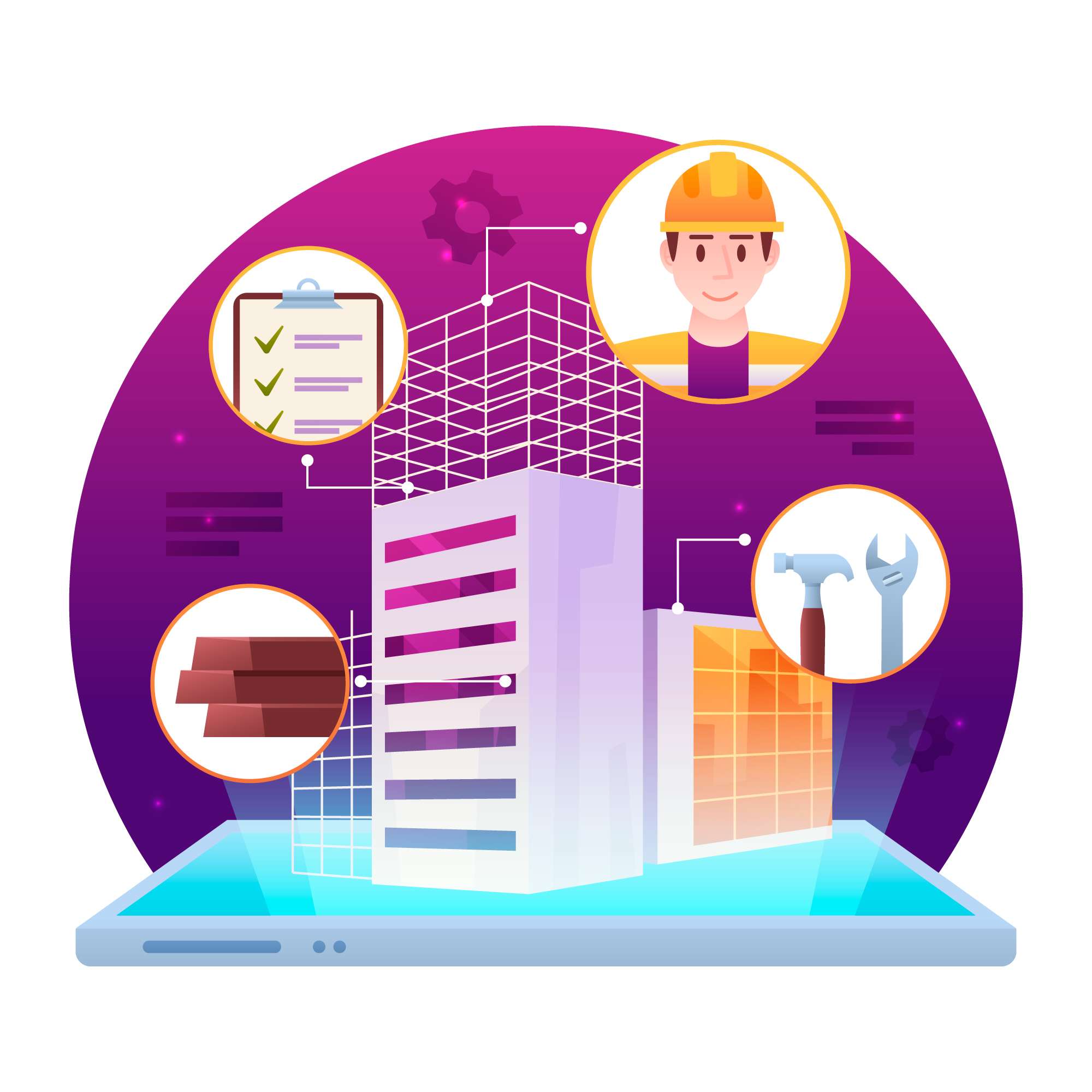
Cost Estimates
- Detailed Cost Breakdown by Phase and Task
- Subcontractor and Supplier Cost Analysis
- Contingency Planning for Unforeseen Expenses
Quality Control and Assurance
- Quality Standards and Technical Specifications
- Inspection and Testing Protocols
- Quality Assurance Documentation Requirements
- Quality Control Roles and Responsibilities
A project manager or construction planner typically develops the work programme during early project stages before commencement. The programme undergoes regular updates throughout project progression. Development involves collaboration with estimators, engineers, and surveyors to incorporate specialized expertise.
What Are Construction Work Programmes Used For?
As a project manager, you understand construction projects present complex challenges. A construction work programme transforms complexity into manageable tasks with allocated resources and clear deadlines. This strategic roadmap maintains project alignment, prevents delays, and ensures budgetary compliance. Here's how they deliver value:
Planning and Scheduling
Construction work programmes enable comprehensive project planning and scheduling. They identify tasks, resources, and timelines for each phase, creating detailed schedules that ensure timely, budget-compliant completion.
Communication
A construction work schedule facilitates transparent communication among all stakeholders—clients, contractors, and subcontractors. With unified understanding, you can guide projects toward successful delivery while minimizing misunderstandings.

Resource Allocation
Construction programmes ensure optimal resource deployment—directing the right resources to appropriate tasks at precise times. This covers human resources (labor) and material resources (equipment and supplies), preventing bottlenecks and delays through strategic allocation.
Monitoring and Control
You leverage construction work programmes to monitor progress and proactively address potential issues. This vigilant approach maintains project trajectory, preventing schedule delays and cost overruns.
Why Is a Construction Programme Important?
Construction work programmes play crucial roles in streamlining processes through structured approaches that reduce inefficiencies and maximize productivity. This methodology minimizes wasted time and effort, creating significantly more efficient project execution. Additional importance includes:
Reduced Risk of Delays and Cost Overruns
Construction work schedules help manage risks affecting timelines and budgets. Early risk identification and mitigation reduces potential delays and cost escalations.

Performance Measurement
Key Performance Indicators (KPIs) provide crucial success metrics for construction projects. These indicators help project managers accurately measure and evaluate project performance.
Quality Management
Detailed construction work programmes establish clear frameworks for contractual compliance. They ensure all parties adhere to agreed scopes of work, timelines, and resource allocations, preventing defects, rework, and costly errors through meticulous attention to detail.
How To Create a Construction Programme?
Creating a comprehensive construction plan is crucial for project success. Follow this step-by-step guide to develop an effective construction work program:
Step 1: Gather Project Information
Collect all relevant project details including scope, budget, and schedule constraints. This information forms the foundation for developing your construction schedule.
Step 2: Develop a Work Breakdown Structure (WBS)
Divide the project into smaller, manageable tasks. This hierarchical structure helps visualize project scope and identify activity dependencies.
Step 3: Estimate Task Durations
Determine realistic completion timelines for each task. Consider resource availability, complexity, and historical data from similar projects. Utilize expert judgment and industry benchmarks for accuracy.
Step 4: Identify Task Dependencies
Determine which tasks require completion before others can commence. This ensures activities proceed in correct sequence.
Step 5: Create a Gantt Chart
Develop visual representation of your construction work schedule. The Gantt chart should display start/end dates and task dependencies, serving as valuable communication tool for stakeholders.
Step 6: Assign Resources
Determine personnel assignments and equipment/material requirements for each task. This encompasses labor, equipment, and materials.
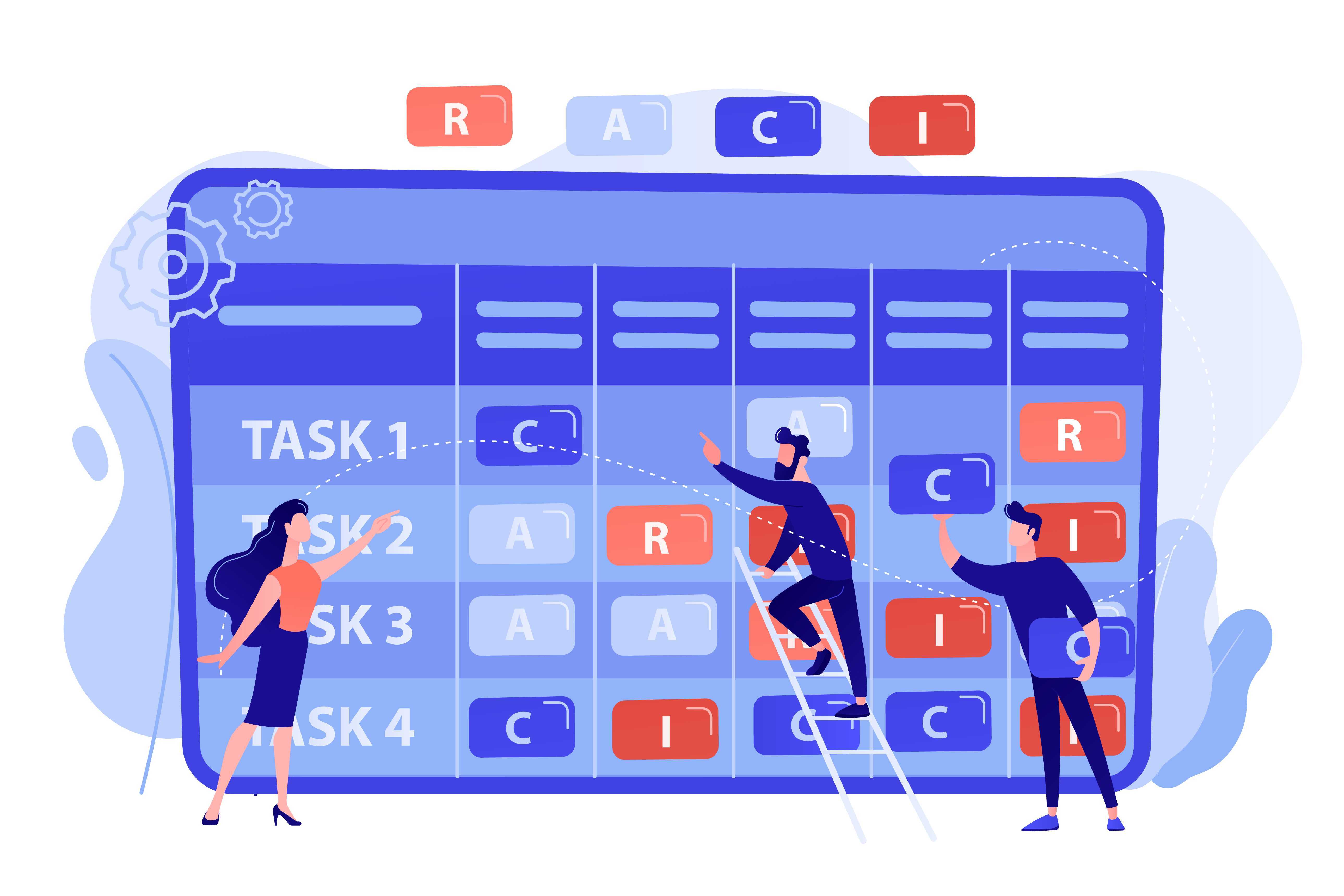
Step 7: Review and Update the Programme
Continuously assess and refine the construction project plan to reflect real-time developments. This may involve adjusting durations, adding/removing tasks, or reallocating resources.
Sample of a Construction Programme
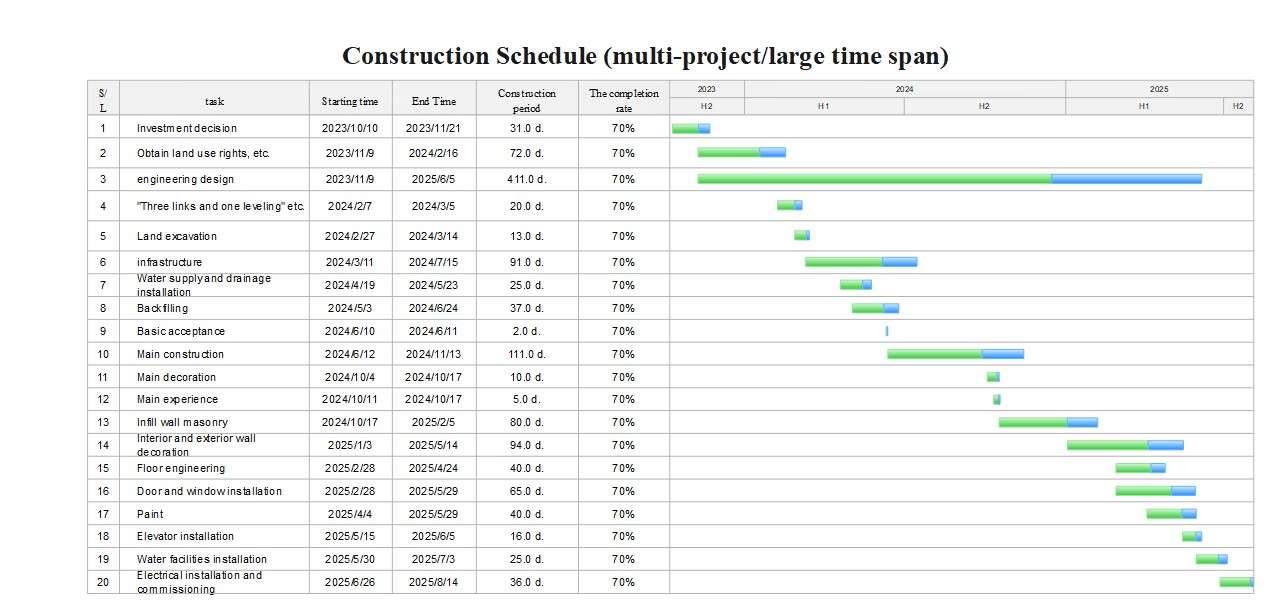
To better understand construction work programmes, examine the sample above. This multi-project schedule displays task timelines via Gantt chart, providing visual progress tracking. The current 70% completion rate indicates significant advancement while highlighting remaining tasks. This visual tool enables strategic adjustments for optimal project management.
Use Software To Manage Your Construction Programme
Gantt chart makers represent widely utilized tools for creating construction work programmes. These visualizations display task durations and dependencies, helping project managers plan, track, and communicate progress effectively. Consider these factors when selecting a Gantt chart maker:
- Ease of Use
Select software with intuitive interface and user-friendly design for efficient project management.
- Scalability
Ensure the Gantt chart maker handles projects of varying sizes and complexities. Adaptability guarantees your tool grows with your project portfolio.
- Budget
Gantt chart makers vary in pricing. Determine the budget alignment with your project requirements.
- Advanced Features
Seek features like resource management, progress tracking, and reporting capabilities.
EdrawProj: A Versatile Gantt Chart Maker for Construction Projects
EdrawProj is a powerful Gantt chart maker featuring construction-specific capabilities. Its user-friendly interface and large-project handling make it ideal for managing small to complex construction work schedules.
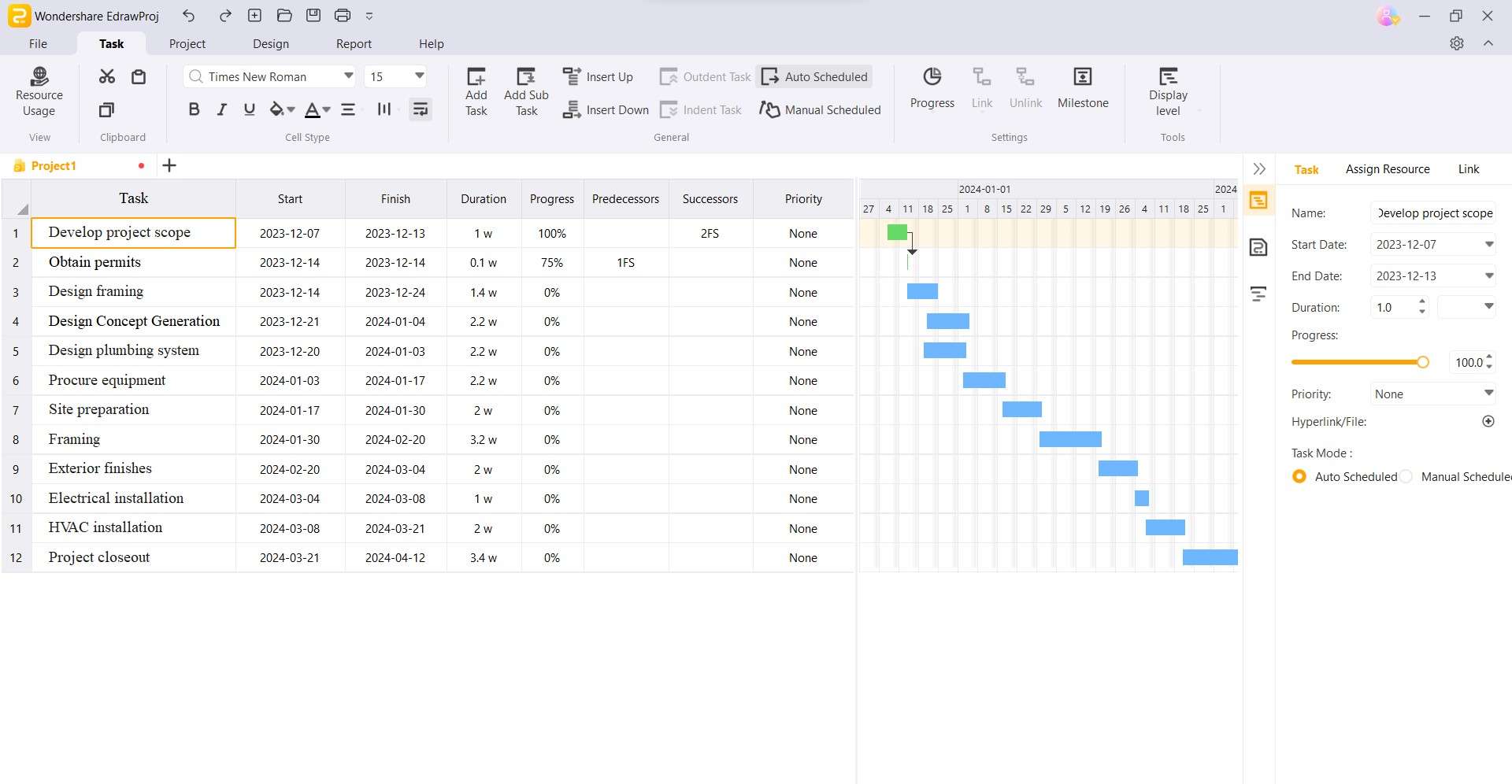
- Task Management
Create detailed task schedules with subtask breakdowns and dependency settings. EdrawProj enables comprehensive task organization.
- Resource Management
Track time and effort requirements per task with appropriate resource assignments. This prevents bottlenecks and ensures team efficiency.
- Progress Tracking
Update task progress, monitor milestones, and identify delayed tasks for proactive management.
- Project Reporting
Generate insightful reports on project progress and performance, including completion rates, cost details, remaining work hours, and resource allocation.
Conclusion
Ready to launch your construction project? Begin with a proven plan that drives success. A clear construction work programme helps avoid costly delays and maintains budgetary control.
Simplify schedule creation with EdrawProj. This intuitive Gantt chart maker enables effective timeline visualization, necessary adjustments, and professional Gantt charts within minutes. With EdrawProj, your project maintains alignment from initiation through completion.
A professional Gantt chart tool to plan, manage and track your projects, process and resources.

